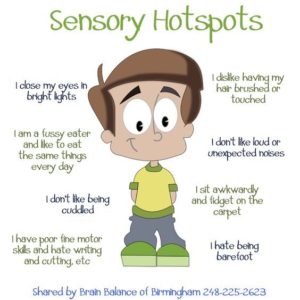We all have 8 senses
Click on the picture to enlarge and see how sensory processing needs in each of the 8 senses might impact a child or young person’s behaviour and how they react to their environment.
We all have sensory preferences and we all have different things we do to help us:
- to stay calm (music, walks, cuddling pets)
- to stay focused and alert (coffee, music, exercise)
- to respond to our sensory environment (turn the radio down, shade our eyes from the sun, avoid or seek out certain smells)
We would consider a child to have sensory processing needs when their sensory processing starts to impact on their ability to participate in everyday activities, to engage at school or to spend time with friends. However, just because a child processes sensory input in a different way doesn’t mean it’s not helpful
e.g. a child might flap their hands when excited or distressed (this is called stimming) – this is a really good way for a child to regulate and we shouldn’t discourage this behaviour as long as the child is safe.
and it doesn’t mean we need to change the child……….often, making changes to the environment is more successful for improving how a child engages in daily activities.

A child with sensory processing needs might be over responsive, under responsive, or somewhere in the middle.
The child with a high threshold needs much more input for events and stimuli to register, so is said to be hypo or under-responsive to stimuli. For example a child or young person might:
- fall and appear to register no pain because their touch system is hypo-responsive
- constantly climb or spin without getting sick or dizzy if their vestibular or movement system is hypo-responsive
- put everything including non-edible items in their mouth if their taste system is hypo-sensitive
The child who has a low threshold only needs a small amount of stimuli for it to register, and so we could say they were hyper or over-responsive. For example a child or young person might:
- become distressed or agitated in response to gentle touch if their touch system is hyper-responsive
- cover their ears or avoid noisy environments because their auditory system is hyper-responsive
- avoid certain smells or tastes as a result of a hyper-responsive taste system
A child could be hyper-responsive to sounds, hypo-responsive to touch and cope fine with smells. Thresholds can be affected by hormones, fatigue, illness etc. so can vary from day to day & mood to mood. And the idea of thresholds applies to us all. Consider your own sensory needs and how they differ depending on how you feel for example how loud you have the radio volume may change depending on the time of day.
Other things can affect how we interpret a sensory experience too, such as the duration and intensity of the stimuli, and the contrast it creates.
The duration of the sensory experience can make the processing and interpretation different, too short and the person can’t get used to it to it and so it is anxiety provoking rather than calming or alerting. Too long and it may become distressing.
An example would be when you get splashed with water when you are dry and fully clothed – you really notice being wet but if you are splashed in the swimming pool and are already wet, there is less contrast and it is not such an upsetting experience. This is why some children become upset going into the bath; dry to wet and also coming out of the bath; wet to dry. Contrast this with when they are happy playing in the bath once they are in.
Neurodiversity and Sensory Processing Needs
Children who have needs affecting their social communication skills, attention and concentration skills, general development and learning may also demonstrate sensory processing differences. A diagnosis of e.g. Autism Spectrum Disorder (ASD) or Attention Deficit Hyperactivity Disorder (ADHD) does not automatically mean that child will have sensory processing needs, however, often how they process the many sensory inputs can impact their ability to understand, to engage and to regulate. Therefore, it is important to assess and consider whether adaptations to the environment can be made to mitigate some of the impact or whether the child would benefit from certain strategies to support them to manage their sensory needs.

